

Switchback Travel


Switchback Travel
Price: $140
Weight: 2 lbs. 12 oz.
Capacities: 24, 26, 34, 36, 50L
What we like: Extremely comfortable and supportive; fantastic back ventilation.
What we don’t: Pricey and heavy for its capacity.
See the Osprey Stratos 24 See the Women's Sirrus 24
Osprey is a leader in the pack market, and their Stratos line is an all-around favorite for day hiking. We’ve owned multiple variations over the years, and all have delivered nearly flawless performance through extended, rough use. We’ve been testing the latest Stratos 24 since its release in 2017 and have been very happy overall. It carries heavy loads comfortably, keeps your back ventilated with its suspended mesh panel, and has tons of pockets and features for organization. Below we break down our experiences with the Stratos 24. To see how it stacks up to the competition, see our article on the best daypacks.
In terms of carrying comfort, the Osprey Stratos 24 is as good as it gets in the daypack market. It’s essentially a shrunken-down version of a deluxe backpacking model—even its max load capacity of 25 pounds isn’t far off from some overnight bags. The mesh backpanel conforms nicely to your back, the padding is downright plush for its capacity, and the metal frame puts the weight mostly on your hips (most daypacks carry more on your shoulders). The solid structure and suspended backpanel also keep the pack from drooping under a heavy load, and you never really feel what’s inside the bag along your back. There are downsides to the design—the frame and features make it heavy—but purely from a comfort perspective, the Stratos is a true standout.
The Stratos 24 tips the scales at 2 pounds 12 ounces, which makes it one of the heaviest daypacks among those with similar mid-20-liter capacities. For reference, Osprey’s popular Talon 22 is much lighter at 2 pounds 1 ounce (for the S/M size), Gregory’s Inertia 25 is 1 pound 9.4 ounces, and CamelBak’s Fourteener 26 is 2 pounds 5 ounces. Even Granite Gear’s much larger Crown2 38 beats it in weight by 8 ounces. But all of those packs are missing the Stratos’s sturdy metal frame, which is the big difference-maker. Depending on your needs, the Stratos’s weight can be the reason to avoid it, but the extra ounces deliver excellent comfort, back ventilation, and features.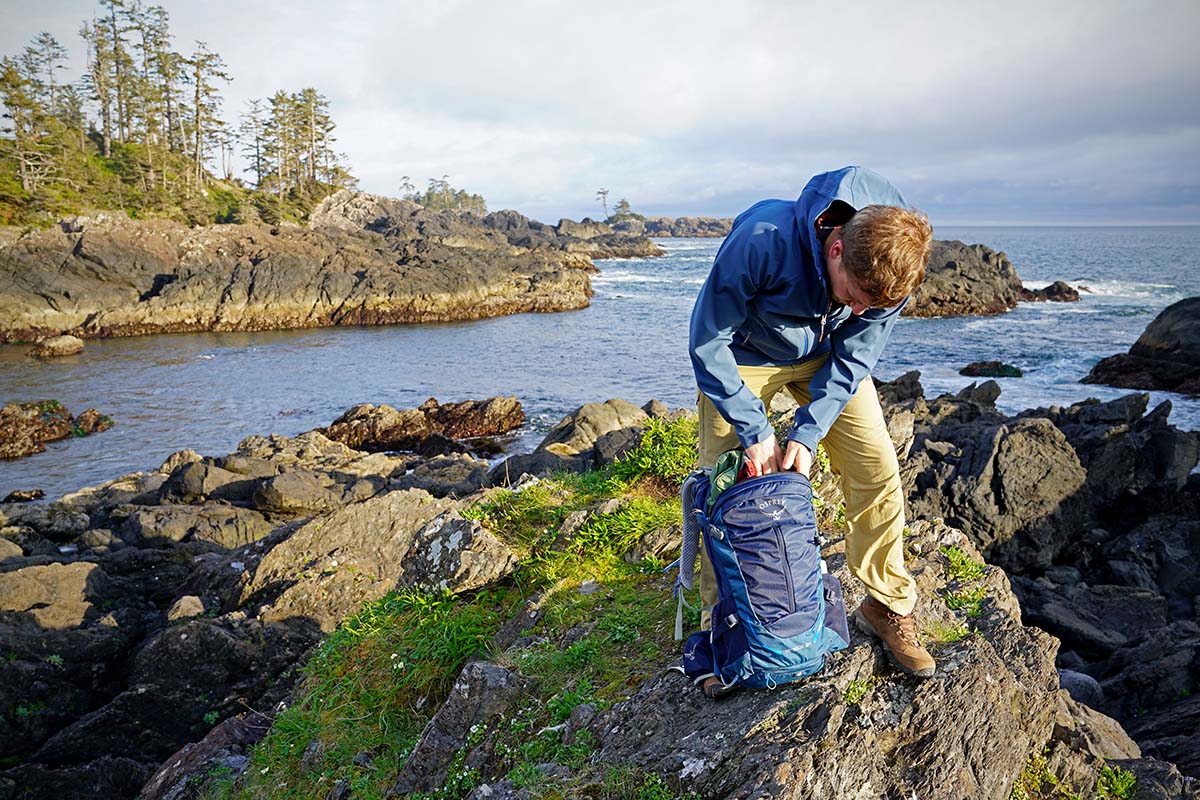
Like many of its backpacking cousins in the Osprey lineup, the Stratos uses a mesh backpanel to keep your back as dry as possible. This is pretty unique in the daypack market—very few designs have the open space behind the mesh to create that kind of airflow. The downside of the ventilation is that it cuts a little into the main compartment capacity, makes it more difficult to compress (some daypacks literally roll up, but the Stratos is rigid) and likely contributes to the premium $140 price tag. Nevertheless, it’s a welcome feature for warm summer hikes or long days on the trail.
Organization is another strong suit of the Osprey Stratos 24. You get an internal hydration sleeve and exit port, two side mesh water bottle pockets, and two nicely sized zippered pockets on the hipbelt. For exterior storage, there is one zippered mesh pocket at the top of the pack with a key clip, another small pocket with enough space for bars or a headlamp, and a tall vertical zippered pocket along the pack body. If we were to nitpick, converting the vertical pocket into a stretchy mesh design would make it even more useful. But overall, the Stratos is hard to beat for those who like quick access to their gear.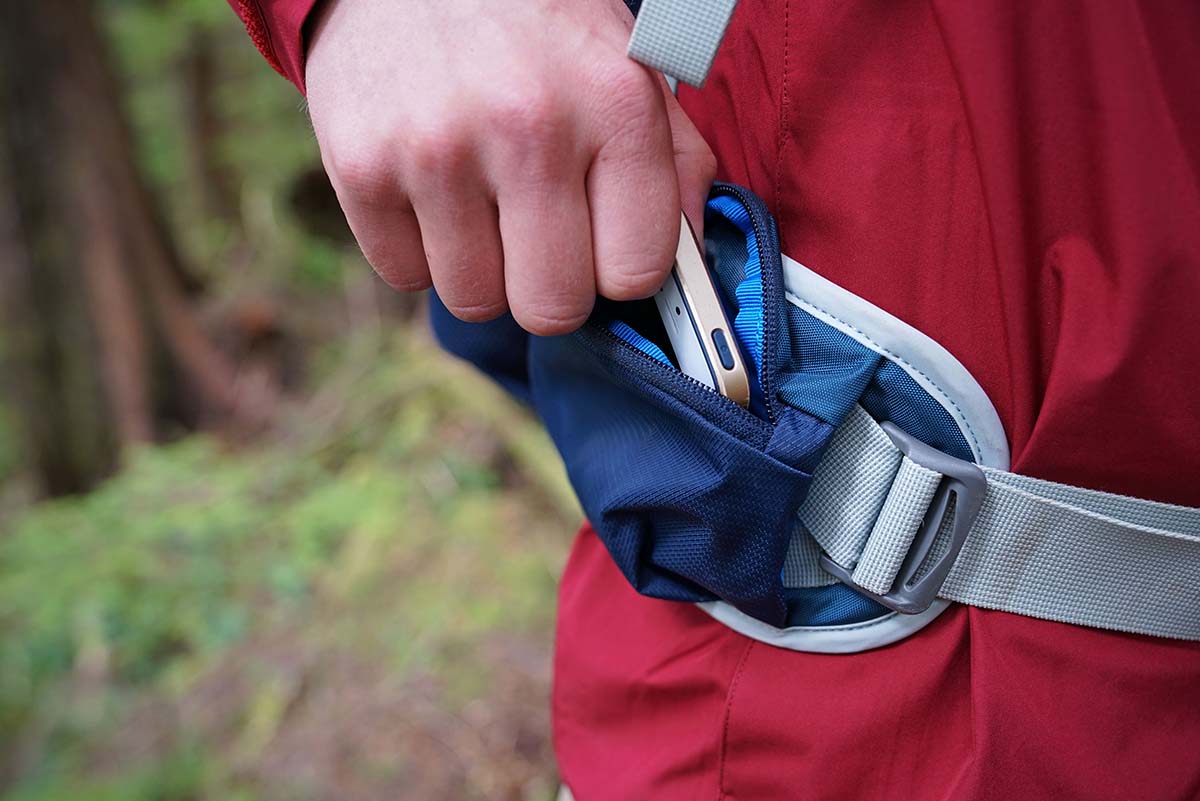
As a feature-rich daypack design, you get a lot of extras that typically are associated with a backpacking model. The Stratos comes with a rain cover that has its own zippered compartment at the bottom, there’s an ice axe loop and toggle cord for cinching it along the pack body, and a trekking pole attachment on the left-hand shoulder strap. And importantly, all these extras are top-quality—none of the straps or cords have frayed or broken down even after extensive use.
Made with a combination of 210-denier nylon on the pack body and 420-denier nylon covering the bottom, the Stratos has a tough build. We’ve set ours down numerous times on rough granite, branches, and rock-covered trails, and the pack is showing only the smallest signs of wear. Additionally, the buckles are high-quality, the zippers work very smoothly, and even the mesh backpanel clearly is tough. The only notable areas of weakness are the mesh water bottle pockets that have a couple small tears from squeezing between rocks and branches on the trail (this is quite common with these types of holsters). All told, we consider the Stratos to be a durable daypack that should last for years.
In the past, the Stratos was available in multiple sizes, but Osprey made the surprising decision to only offer a single size with the latest model (there are men’s and women’s-specific designs, however). The good news is that the shoulder straps can be easily adjusted up and down with a Velcro attachment for various torso lengths, and we’ve had no problems sharing the pack with people ranging from 5’4” to over 6 feet. It’s also simple to dial in the fit with the large hipbelt adjusters and easy-to-access load-lifter straps. Given the high level of adjustability, the lack of size options isn’t optimal but seems reasonable.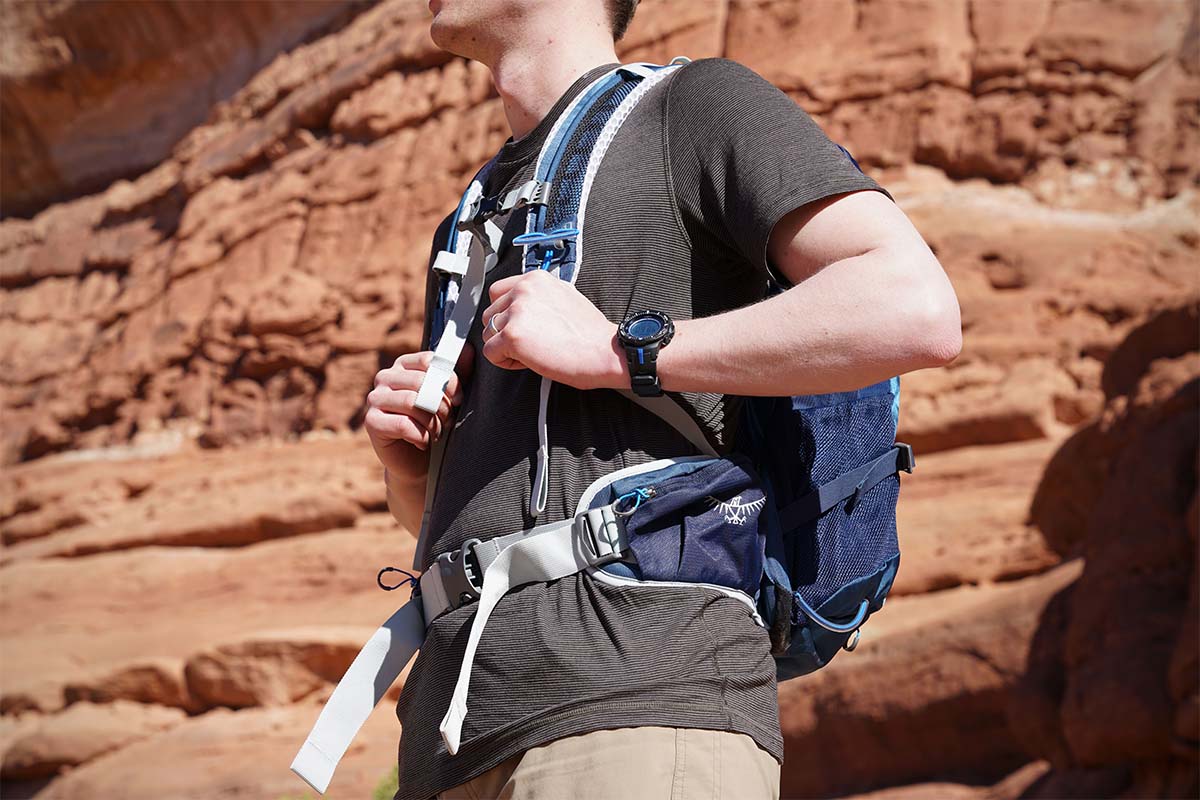
We tested the 24-liter version of the men’s Stratos, which is the smallest-capacity version. Within the larger Stratos collection, Osprey also offers larger 26, 34, 36, and 50-liter models. The 26-liter model is most similar to the version tested here (it even costs the same), with the only major difference being the slight boost in capacity. Stepping up to the Stratos 34 gets you more storage options, including a zippered sleeping bag compartment. The 36- and 50-liter models also share a lot in common with the 24, but they add a top lid as well as zippered access to the bottom of the bag (of course, weight also goes up). All in all, we think the 24 is the best choice for most done-in-a-day activities. Alternatively, the 36 is a good option for those who need to carry a little extra or want to use it for minimalist overnight trips, and the 50 is a solid backpacking bag (or a large daypack for carrying an entire family’s worth of food and gear).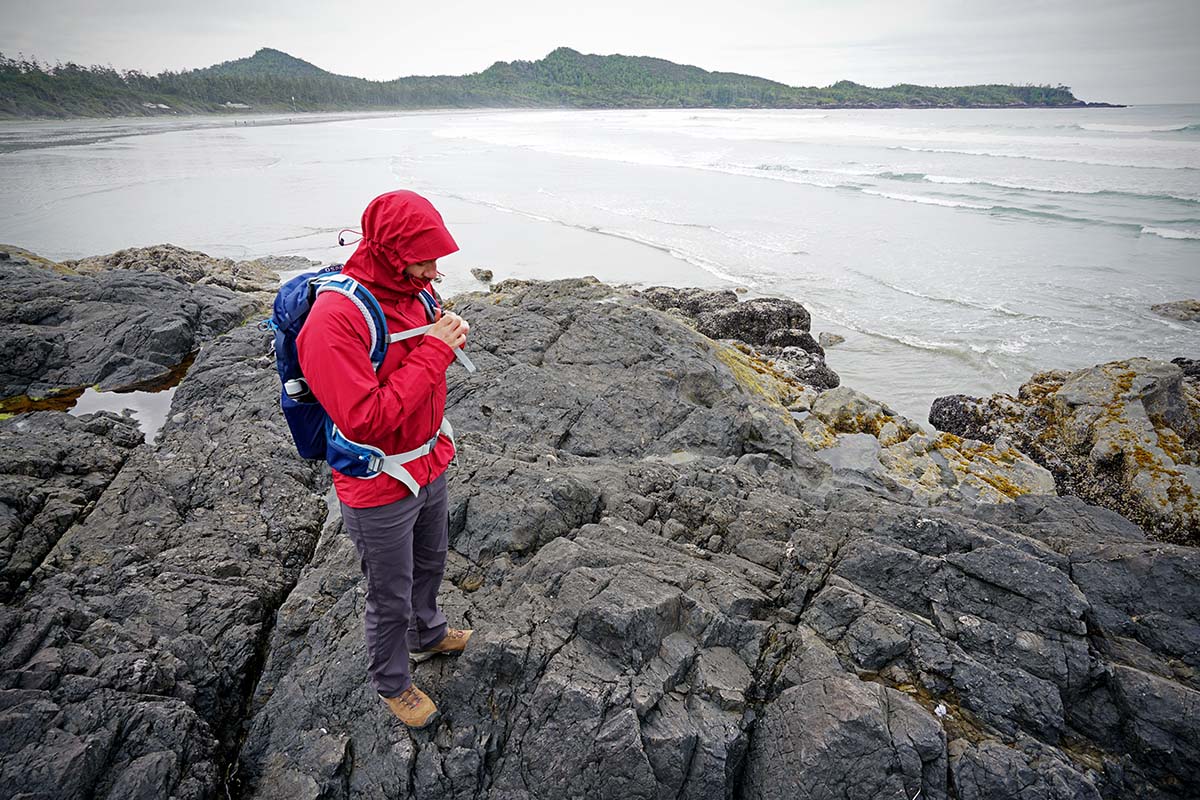
The Stratos is a men’s or unisex design, but Osprey makes the same pack in a women’s-specific model called the Sirrus. Stacked up against the Stratos 24, the Sirrus 24 shares the same overall design but with a women’s-specific fit and different available colorways. Like the men’s versions, the Sirrus lineup also is offered in 26, 36, and 50-liter capacities (although there’s no 34L option). We haven’t tested the women’s Sirrus just yet, but given the nearly identical build, we’d expect to have similar praise about the pack’s suspended mesh backpanel, impressive on-trail comfort, and excellent feature set.
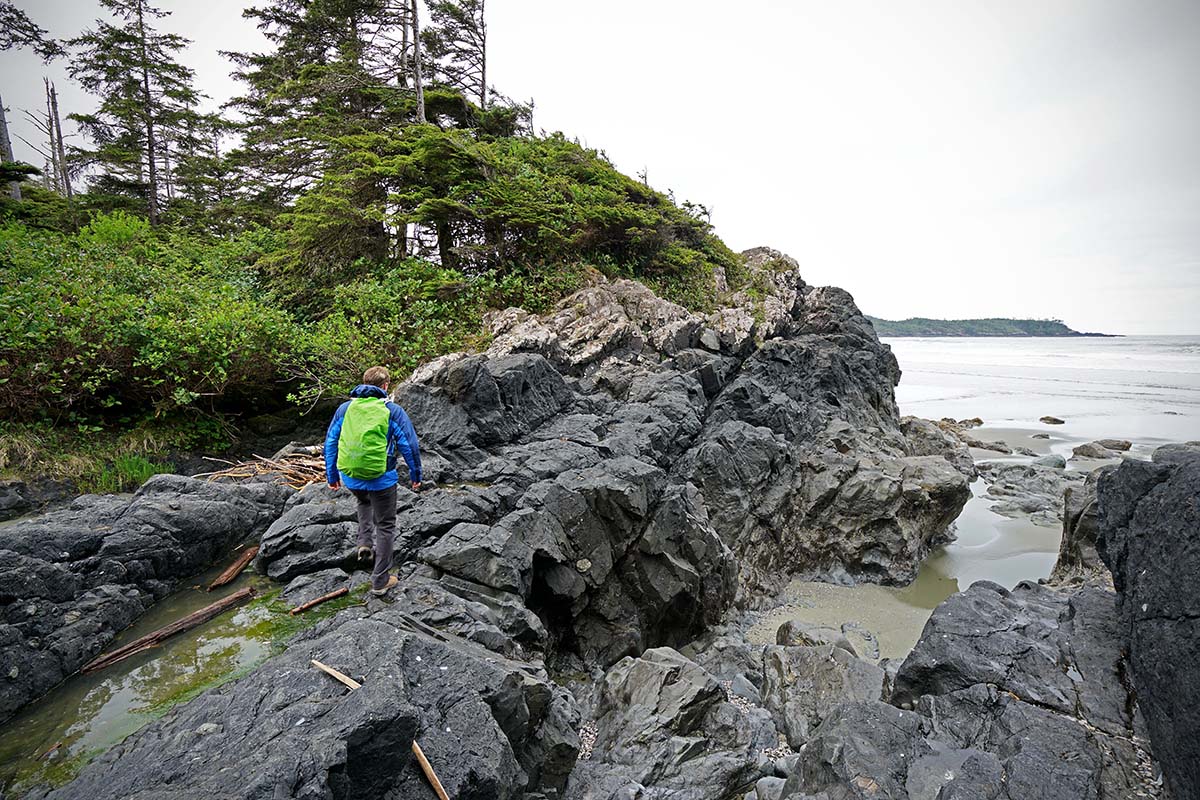
| Daypack | Price | Weight | Capacities | Hipbelt | Frame | Pockets |
|---|---|---|---|---|---|---|
| Osprey Stratos 24 | $140 | 2 lb. 12 oz. | 24, 26, 34, 36, 50L | Cushioned | Alloy frame | 5 exterior |
| Osprey Talon 22 | $130 | 2 lb. 1 oz. | 11, 22, 26, 33, 36, 44L | Cushioned | Backpanel | 7 exterior |
| Osprey Manta 24 | $160 | 2 lb. 14.3 oz. | 24, 34L | Cushioned | Backpanel | 7 exterior |
| CamelBak Fourteener 26 | $155 | 2 lb. 5 oz. | 26L | Cushioned | Backpanel | 8 exterior |
| Gregory Miwok 24 | $120 | 1 lb. 13.6 oz. | 12, 18, 24L | Cushioned | None | 8 exterior |
| REI Co-op Trail 25 | $80 | 2 lb. | 25, 40L | Webbing | HDPE frame | 5 exterior |
With its impressive combination of comfort, ventilation, and organization, the Stratos is one of the best premium daypacks on the market. From within Osprey’s own lineup, we also love their Talon 22 and women’s Tempest 20. This series is extremely popular and for good reason: the packs are light, well-made, have enough capacity and comfort for hauling a standard day hike's worth of stuff, and undercut the Stratos in price by $10. Where the packs differ most is in carrying comfort: while the Talon excels at hauling extra layers, food, and a few other essentials, it doesn’t have a frame—or even a solid framesheet—so it can droop and become uncomfortable with heavier loads. If you plan on carrying a lot of water or other heavy items, the comfort of the Stratos is tough to beat, and it comes with an integrated rain cover (the Talon does not).
Another Osprey design to consider is their Manta 24, which sits at the top of the brand’s daypack lineup at $160. What do you get for the extra cash? To start, the Manta includes a 2.5-liter hydration reservoir, boasts an included rain cover and adjustable torso for more easily dialing in fit, has a raised backpanel for added ventilation and carrying comfort, and sports compression straps for snugging down a load. The biggest downside with the Manta is weight (it checks in at 2 lbs. 14.3 oz.), although the Stratos is only a couple ounces lighter. In the end, we still consider the Stratos to be the more well-rounded design, but the Manta is a nicely appointed alternative and a decent value for those who don’t already own a reservoir.
CamelBak is another company with a strong reputation, and their top daypack is the Fourteener 26. Compared to the Stratos, the CamelBak is a solid alternative: it has very good organization, the articulating backpanel both ventilates well and conforms nicely to your back, and it comes with a 3-liter hydration reservoir. But the Osprey has nicer padding along the hipbelt and shoulder straps, its compression straps do a better job keeping the load pulled in close, and we think it’s the better choice if you don’t need a hydration reservoir (you can only get the Fourteener 26 with the 3-liter system). Both are great options, but the Stratos is the slightly most complete design.
Gregory’s Miwok lineup (12, 18, 24, 32, and 42-liter packs) is another intriguing alternative to the Stratos. In particular, we like the 24-liter model: it’s reasonably priced at $120, lightweight at 1 pound 13.6 ounces, and—like the Stratos 24—has a max load capacity of 25 pounds. The Miwok 24 also features an adjustable torso and similar pocket layout to the Stratos. However, the Stratos is a much better breather with its mesh-heavy backpanel (the Miwok uses foam), and we prefer the Osprey’s sturdy metal frame. Despite the weight penalty, we give the edge to the more supportive and well-ventilated Stratos, plus the included rain cover helps make up for the price difference.
Our final option to consider also is the most affordable: REI Co-op’s Trail 25. For only $80, the Trail comes nicely appointed with a hydration sleeve, wide U-shaped opening, ample organization and external storage options, trekking pole attachment points, and an included rain cover. However, at this price point, you do forego a cushioned hipbelt for simple webbing, which has a significant impact on comfort, and we prefer the Stratos’ more breathable backpanel design. All in all, for light trail work or travel, the REI is a nice option and saves you a considerable $60. But for shuttling a full day’s worth of gear, the Stratos has the clear comfort advantage.